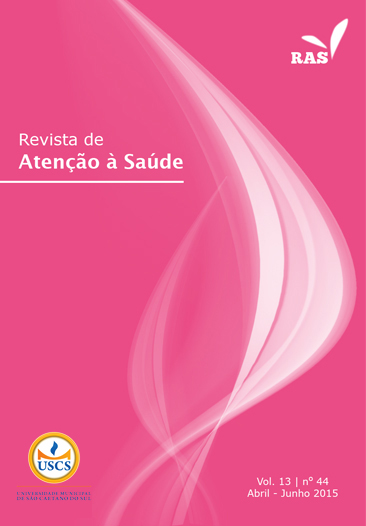NURSING INTERVENTIONS USED FOR THE EARLY SCREENING OF CERVICAL UTERINE CANCER: INTEGRATIVE REVIEW
DOI:
https://doi.org/10.13037/ras.vol13n44.2530Keywords:
Prevention of cervical cancer, cervical neoplasia, nursingAbstract
Introduction: The cervical uterine cancer (CUC) is very prevalent throughout the world. If prematurelydiagnosed, it presents a potential prevention and cure chance of approximately 100%. Objective: Todescribe the national knowledge produced about the interventions used in the early detection of cervicalcancer. Method: literature review. Data collection was performed on the data basis LILACS and SciELOelectronic library in August of 2012, with the combination of the descriptors “prevention of cervical cancer”,“cancer of the cervix” and “nursing”. For a description of selected research we used absolute frequency(n), percentage (%) and the organization of data by similarity. Development: All interventions, whetherthey were social, behavioral, or cognitive, proved to offer positive effects on early screening of the CUC,however, it is suggested a combination of interventions to increase the efficiency of the approach. Conclusion:The primary strategy and early detection are the most suitable instruments for reducing morbidityand mortality caused by the disease, and the nurse, because of its many opportunities for action, proves tobe adequate to support the minimization of this diseaseDownloads
References
1. World Health Organization,. International Agency for Research on Cancer. Globocan 2008. 2010 [acesso em: 25 jan. 2012]. Disponível em: http://globocan.iarc.fr/.
2. Galvão MTG, Freitas JG, Costa E, Lima ICV, Brito DMS, Diógenes MAR. Mulheres com HIV: características individuais e da prevenção de Câncer Cervical. Rev Rene. 2010;(11):99-108.
3. Organización Mundial de la Salud. Control integral del cáncer cervicouterino: guía de práticas esenciales. Geneva; 2007.
4. Casarin MR, Piccoli JCE. Educação em saúde para prevenção do câncer de colo do útero em mulheres do município de Santo Ângelo/RS. Ciênc Ssaúde Ccolet [periódico na Internet]. 2011 [acesso em: 23 set. 2012];16(9):3925-3932. Disponível em: http://www.scielo.br/pdf/csc/v16n9/a29v16n9.pdf
5. Oliveira WA, Barbosa MA, Mendonça BOM, Silva AA, Santos LCF, Nascimento LCD. Adesão de mulheres de 18 a 50 anos ao exame colpocitológico na Estratégia Saúde da Família. Rev Eenf Rref [periódico na Internet]. 2012 [acesso em: 23 set 2012];(7):15-22. Disponível em: http://www.scielo.gpeari.mctes.pt/scielo.php?script=sci_arttext&pid=S0874-02832012000200002&lng=pt
6. Anticaglia CM, Souza PRK, Raitz R. Conhecimento de estudantes universitários sobre HPV, sua relação com câncer de útero e métodos preventivos. Rev Bbras Cciênc Ssaúde. 2008 [acesso em: 23 set 2012];3(15). Disponível em: http://seer.uscs.edu.br/index.php/revista_ciencias_saude/article/view/536/381
7. Brasil. Ministério da Saúde, Secretaria de Atenção à Saúde, Departamento de Atenção Básica. Controle dos cânceres do colo do útero e da mama. Brasília. 2006.
8. Rogers NM, Cantu AG. The nurse’s role in the prevention of cervical cancer among underserved and minority populations. J Ccommun Health. 2009;(34):135-43.
9. Ferreira MLSM. Motivos que influenciam a -não realização do exame de papanicolau segundo a percepção das mulheres. Esc Anna Nery Rrev Eenferm. 2009 [acesso em: 23 set 2012]; 13(12):378-84. Disponível em: http://www.lume.ufrgs.br/bitstream/handle/10183/27055/000751961.pdf?sequence=1
10. Souza MT, Silva MD, Carvalho R. Revisão Integrativa: o que é e como fazer. Rev. Einstein [periódico na Internet]. 2010 [acesso em 12 set 2012];8(1):102-06. Disponível em: http://apps.einstein.br/revista/arquivos/PDF/1134-Einsteinv8n1_p102-106_port.pdf
11. Yabroff KR, Mangan P, Mandelblatt J. Effectiveness of interventions to increase Papanicolau smear use. J Aam Bboard Ffam Mmed. 2003;16(3):188-203.
12. Amodele O, Aeyomoye AAA, Awodele F, Kwashi V, Awodele IO, Dolapo DC. A study on Cervical Cancer Screening amongst nurses in Lagos University Teaching Hospital, Lagos, Nigeria. Journal Ccanc Eeduc. 2011 [acesso em 03 out 2012];26(3):497-504. Disponível em:
http://www.ncbi.nlm.nih.gov/pmc/articles/PMC3161190/pdf/13187_2010_Article_187.pdf
13. Melo MCSC, Vilela F, Salimena AMO, Souza IEO. Enfermeiro e prevenção do Câncer do Colo do Útero: o cotidiano da Atenção Primária. Rev Bbras Ccancerol. 2012 [acesso em 28 out 2012];58(3):389-398. Disponível em: http://www.inca.gov.br/rbc/n_58/v03/pdf/08_artigo_enfermeiro_prevencao_cancer_colo_utero_cotidiano_atencao_primaria.pdf
14. Vasconcelos CTM, Damasceno MMC, Lima FET, Pinheiro AKB. Revisão integrativa das intervenções de enfermagem utilizadas para detecção precoce do câncer cérvico-uterino. Rev Llatinoam Eenferm. 2011 [acesso em 28 out 2012];19(2):1-8. Disponível em: http://www.scielo.br/pdf/rlae/v19n2/pt_28.pdf
15. Silva SS; Aquino TAA; Santos RM. O paciente com câncer: cognições e emoções a partir do diagnóstico. Revista Bbras
Tter Ccogn. 2008 [acesso em: 23 set 2012];4(2):73-87. Disponível em: http://pepsic.bvsalud.org/pdf/rbtc/v4n2/v4n2a06.pdf
16. Silva SR, Lício FC, Borges LV, Mendes LC, Vicente NG, Gomes NS. Atividades educativas na área da saúde da mulher: um relato de experiência. Rev Eenferm aAtenção Ssaúde. 2012;01(1):106-12.
17. Barbeiro FMS; Cortez EA. Conhecimento e práticas das mulheres acerca do exame Papanicolau e prevenção do câncer do colo uterino. Rev Ppesq Cuid Fundam. 2009;1(2):414-422.
18. Cruz LMB, Loureiro RP. A Comunicação na abordagem preventiva do câncer do colo do útero: Importância das influências histórico-culturais e da sexualidade feminina na adesão as campanhas. Saúde Soc. 2008 [acesso em 28 out 2012];17(2):120-131. Disponível em: http://www.scielo.br/pdf/sausoc/v17n2/12.pdf
19. Casarin MECR, Piccoli JCE. Educação em saúde para prevenção do câncer de colo uterino em mulheres o município de Santo Ângelo/RS. Ciênc Ssaúde Ccolet. 2011 [acessoem 09 nov 2012];16(9):3925-3932. Disponível em: http://www.scielo.br/pdf/csc/v16n9/a29v16n9.pdf.
20. Cirino FMSB, Nichiata LYI, Borges ALV. Conhecimento, atitude e práticas na prevenção do câncer de colo uterino. Esc Anna Nery rRev Eenferm [periódico na Internet]. 2010 [acesso em 03 out 2012];14(1):126-134. Disponível em: http://www.scielo.br/pdf/ean/v14n1/
v14n1a19.pdf
Downloads
Published
Issue
Section
License
Copyright (c) 2015 Luciene Rodrigues Barbosa

This work is licensed under a Creative Commons Attribution-NonCommercial-NoDerivatives 4.0 International License.
Policy Proposal for Journals offering Free Delayed Access
Authors who publish in this magazine agree to the following terms:
- Authors maintain the copyright and grant the journal the right to the first publication, with the work simultaneously licensed under a Creative Commons Attribution License after publication, allowing the sharing of the work with recognition of the authorship of the work and initial publication in this journal.
- Authors are authorized to assume additional contracts separately, for non-exclusive distribution of the version of the work published in this magazine (eg, publishing in institutional repository or as a book chapter), with the acknowledgment of the authorship and initial publication in this journal.
- Authors are allowed and encouraged to publish and distribute their work online (eg in institutional repositories or on their personal page) at any point before or during the editorial process, as this can generate productive changes, as well as increase impact and citation of the published work (See The Effect of Open Access).









